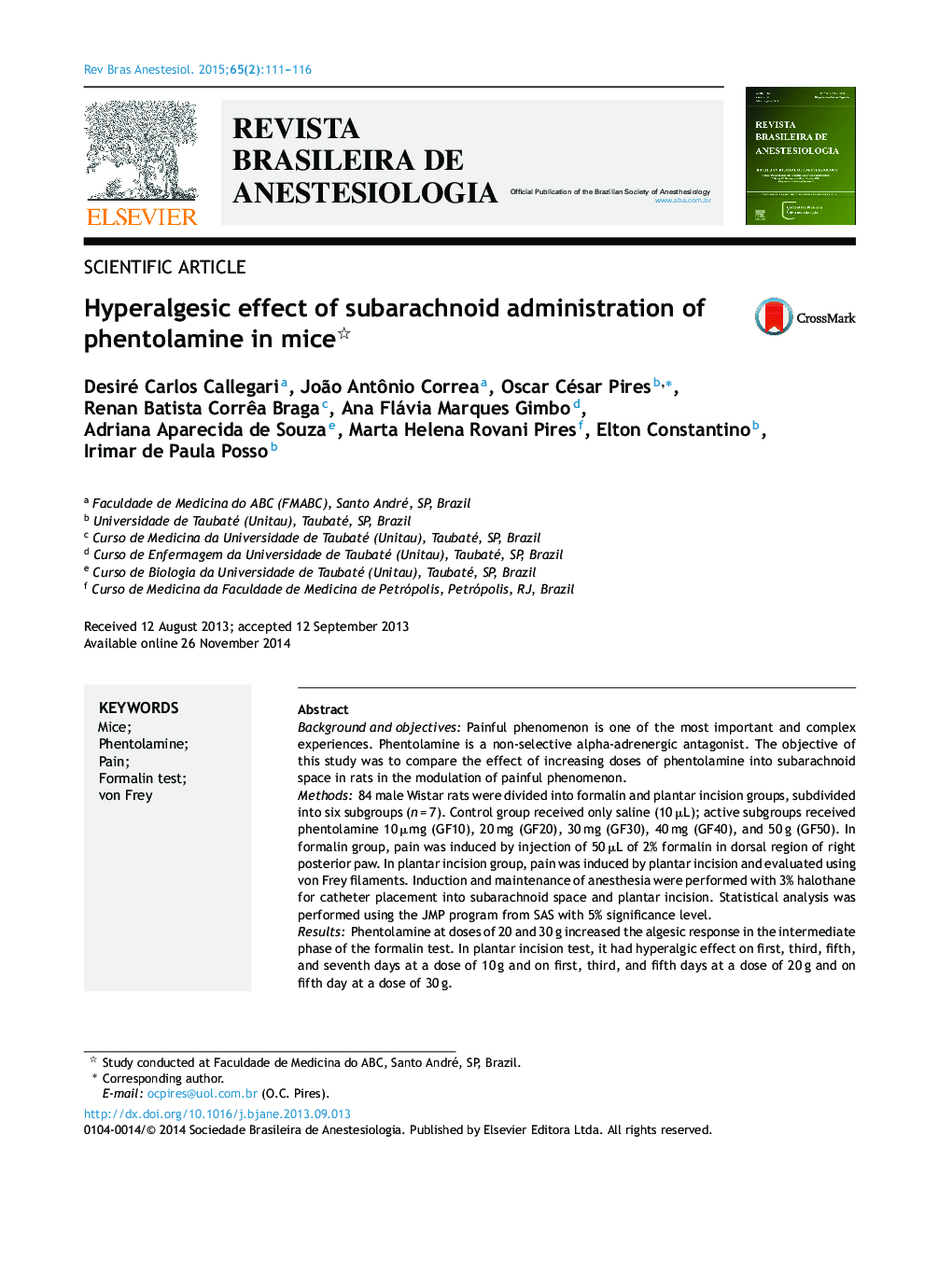| کد مقاله | کد نشریه | سال انتشار | مقاله انگلیسی | نسخه تمام متن |
|---|---|---|---|---|
| 2750127 | 1567305 | 2015 | 6 صفحه PDF | دانلود رایگان |

Background and objectivesPainful phenomenon is one of the most important and complex experiences. Phentolamine is a non-selective alpha-adrenergic antagonist. The objective of this study was to compare the effect of increasing doses of phentolamine into subarachnoid space in rats in the modulation of painful phenomenon.Methods84 male Wistar rats were divided into formalin and plantar incision groups, subdivided into six subgroups (n = 7). Control group received only saline (10 μL); active subgroups received phentolamine 10 μmg (GF10), 20 mg (GF20), 30 mg (GF30), 40 mg (GF40), and 50 g (GF50). In formalin group, pain was induced by injection of 50 μL of 2% formalin in dorsal region of right posterior paw. In plantar incision group, pain was induced by plantar incision and evaluated using von Frey filaments. Induction and maintenance of anesthesia were performed with 3% halothane for catheter placement into subarachnoid space and plantar incision. Statistical analysis was performed using the JMP program from SAS with 5% significance level.ResultsPhentolamine at doses of 20 and 30 g increased the algesic response in the intermediate phase of the formalin test. In plantar incision test, it had hyperalgic effect on first, third, fifth, and seventh days at a dose of 10 g and on first, third, and fifth days at a dose of 20 g and on fifth day at a dose of 30 g.ConclusionSubarachnoid administration of phentolamine showed hyperalgesic effect, possibly due to the involvement of different subclasses of alpha-adrenergic receptors in modulating pain pathways.
ResumoJustificativa e objetivosO fenômeno doloroso é uma das mais importantes e complexas experiências. A fentolamina é antagonista alfa-adrenérgico não seletivo. O objetivo foi comparar os efeitos de doses crescentes da fentolamina, por via subaracnóidea, em ratos na modulação do fenômeno doloroso.MétodoForam usados 84 ratos Wistar machos, divididos nos grupos formalina e incisão plantar, subdivididos em seis subgrupos (n = 7). No subgrupo controle (GC) apenas salina (10 μL), nos subgrupos ativos, 10 μg de fentolamina (GF10), 20 μg (GF20), 30 μg (GF30), 40 μg (GF40) e 50 μg (GF50). No grupo formalina, a dor foi induzida com injeção de 50 μL de formalina a 2%, na região dorsal da pata posterior direita. No grupo incisão plantar, a dor foi induzida por incisão plantar e avaliação pelos filamentos de von Frey. Indução e manutenção anestésica com halotano a 3% para introdução de cateter no espaço subaracnóideo e feitura da incisão plantar. Análise estatística dos resultados pelo programa JMP do SAS com nível de significância 5%.ResultadosA fentolamina nas doses de 20 e 30 μg produziu aumento da resposta álgica na fase intermediária do teste da formalina. No teste da incisão plantar, promoveu efeito hiperálgico no primeiro, terceiro, quinto e sétimo dias na dose de 10 μg, no primeiro, terceiro e quinto dias na dose de 20 μg e no quinto dia na dose de 30 μg.ConclusãoA fentolamina por via subaracnóidea promoveu efeito hiperálgico, possivelmente pela participação de diferentes subclasses de receptores alfa-adrenérgicos nas vias modulatórias da dor.
Journal: Brazilian Journal of Anesthesiology (English Edition) - Volume 65, Issue 2, March–April 2015, Pages 111–116